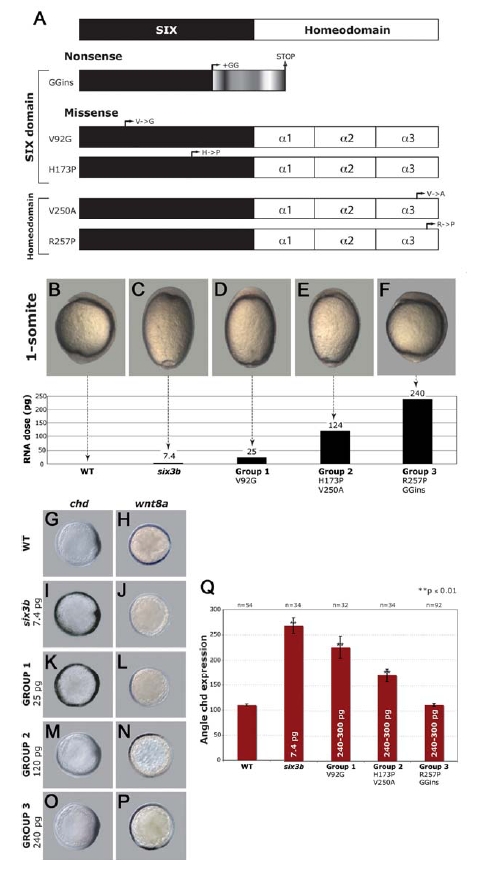Fig. S1
HPE-Associated Six3 Mutants Function as Hypomorphs
(A) Schematic representation of wild-type and HPE-associated SIX3-mutant proteins. The black box represents the Six domain. The three alpha helixes of the homeodomain are indicated.
(B-F) The injected Six3-mutant proteins showed a spectrum of hypomorphic activities in the zebrafish assay that ranged from a slightly decreased ability to dorsalize embryos (Group 1: Six3bV92G), to a greatly decreased dorsalizing potential (Group 2: Six3bV250A, Six3bH173P), to an inability to dorsalize embryos at the injected doses (Group 3: Six3bR257P, Six3bGGins). Wild-type six3b (B) and Group 1 (C) and Group 2 (D) six3b-mutant forms can morphologically dorsalize wild-type embryos into a characteristic egg-like shape, as seen at the 1-somite/10.3-hpf stage. (E) Group 3 mutant forms fail to dorsalize embryos even at very high injection doses (240 pg-1 ng). (G, H) The expression of chd (dorsal marker) and wnt8a (ventral marker) is shown by wholemount in situ hybridization at the 60% epiboly/6.5-hpf stage. (I, J) Wild-type six3b injection shows the expansion of chd around the margin of the embryo, and the downregulation of wnt8a expression. (K-N) Misexpression of Groups 1 and 2 mutant forms causes chd expansion and wnt8a loss similar to wild-type six3b, although higher concentrations were needed. (O, P) Embryos misexpressing group 3 mutant forms have chd and wnt8a expression patterns similar to those seen in uninjected embryos. (Q) Graphical representation of results obtained following injections of equivalent amounts (240-300 pg) of six3b-mutant forms and wild-type six3b. Wild-type six3b and injection of Groups 1 and 2 mutant forms show a statistically significant difference (p ≤0.01) compared to uninjected wild-type embryos; however, injection of Group 3 did not (p >0.05).
Reprinted from Developmental Cell, 15(2), Geng, X., Speirs, C., Lagutin, O., Inbal, A., Liu, W., Solnica-Krezel, L., Jeong, Y., Epstein, D.J., and Oliver, G., Haploinsufficiency of Six3 fails to activate Sonic hedgehog expression in the ventral forebrain and causes holoprosencephaly, 236-247, Copyright (2008) with permission from Elsevier. Full text @ Dev. Cell

